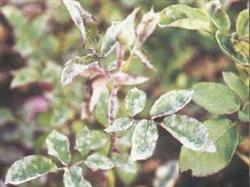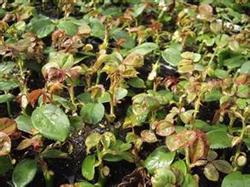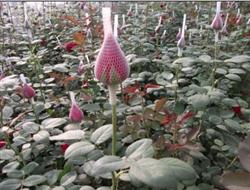Prevention and Control of Common Diseases of Rose

There are four common diseases of rose, such as powdery mildew, black spot, root cancer and branch blight, although other diseases such as exposure fungus, rust and anthracnose are occasionally found. And so on, but not as serious as the first four diseases. The symptoms and control methods are described as follows: rose black spot disease caused by Diplocarponrosae, the pathogen of Scutellariaceae, is the most common disease in rose cultivation, and the disease is the most serious in the period of high temperature and humidity. It occurs in leaves, petioles and stems. When the plant is infected, black round disease spots appear on the leaves, especially the mature leaves close to the ground suffer the most. The diseased leaves will gradually yellowing and fall off. When the disease is serious, most of the leaves of the whole plant fall off, unable to carry out photosynthesis, resulting in poor growth. The most important thing to control rose black spot is to keep the cultivation environment clean, such as cleaning the diseased leaves to prevent fungal spores from spreading, watering the leaves in the morning as far as possible to keep the leaves dry, and the pathogens are less likely to reproduce and spread. Secondly, pay attention to pruning to avoid the clustering of branches and leaves, and keep the plants well ventilated. Chemical control can be used, such as spraying the whole plant with 1000 times of Laide (Yili), once every 5-7 days, 3-5 times continuously, and it can also treat both rust and powdery mildew. Powdery mildew of rose is a fungal disease caused by the pathogen Sphaerothecapannosa. Mainly infected with young leaves, tender stems and buds and other parts, the infection site will appear white powdery disease spots; when severe infection, the leaves will become brittle, atrophied and curled and dry. The onset period of powdery mildew is different from that of black spot disease. when the temperature is low and the relative humidity is high, the occurrence of powdery mildew is more serious, which usually occurs most in winter. Generally speaking, the disease is most likely to occur in humid climate, poor ventilation and lack of sunshine, so rose cultivation in winter must prevent powdery mildew in order to make roses grow well. The prevention and control of rose powdery mildew is the same as black spot disease, we must pay attention to pruning to keep the plants well ventilated, and avoid planting roses in areas where there is not enough light, or isolating from other plants that are prone to powdery mildew, such as hundred-day grass, Dali flowers, and so on. The selection of disease-resistant varieties can reduce the threat of powdery mildew, or spray the whole plant with 1000 times of Ferrari. Root cancer disease is caused by soil bacterial pathogen Agrobacteriumtumefaciens, which mainly affects the stem and root, and often occurs in the part where the plant is in contact with the soil. The infected site swells to form a tumor around the stem, resulting in poor plant growth and death. As root nodule infection is difficult to treat, it is best to remove and burn the infected plant as soon as it is found, and disinfect the planting hole with soil disinfectant before planting. The prevention of root nodule disease is mainly to buy seedlings carefully, before and after planting to avoid causing wounds in the stem, especially near the soil. In addition, the soil near the susceptible plant should not be used to cover the soil to avoid infection. Branch blight is also canker disease, which is caused by fungal pathogens, which enters the plant through the wound, causing all or part of the stem necrosis, and then up or down necrosis, so that the upper branches and leaves of the affected part grow poorly or die. The wound of the rose is mainly caused by pruning, in addition, low temperature cold injury or grafting can also cause the wound, and branch blight can also enter from the stem prick and peel. Generally, branch blight is easy to occur at internodes, so pruning should make the wound close to the node as far as possible to prevent the occurrence of branch blight. In addition, roses planted in large rotation, malnourished plants or infected with black spot disease are more susceptible to infection. To control rose branch blight, the diseased branches should be cut off and burned at any time, because the pathogen will produce spores on the branches for the winter, so the field must be kept clean. 70% alcohol or 10% bleach should be used to disinfect the diseased plant before and after pruning, and the wound should be close to the node when trimming, and 45 angles can prevent pathogens from entering the wound.
- Prev

Breeding and cultivation techniques of Rose
The breeding methods of roses: the breeding methods of roses can be divided into sexual breeding and asexual breeding. The main cultivated varieties in production, such as Pingyin double red rose, Fenghua rose and purple rose, all adopt asexual breeding. Asexual breeding includes ramet, root burying, grafting and tender wood cutting, which are most widely used.
- Next

Common diseases and insect pests of rose and their control
The common diseases of rose are rust, black mildew, powdery mildew and so on. Rust often harms the leaves, young branches and flowers of roses. In the early stage of the disease, the leaves appear red spots such as rust, and when the leaves are serious, the leaves become scorched and fall off, affecting flowering in the coming year. Diseased leaves should be removed in time and destroyed centrally. It can also be sprayed every half month from May to August.
Related
- Fuxing push coffee new agricultural production and marketing class: lack of small-scale processing plants
- Jujube rice field leisure farm deep ploughing Yilan for five years to create a space for organic food and play
- Nongyu Farm-A trial of organic papaya for brave women with advanced technology
- Four points for attention in the prevention and control of diseases and insect pests of edible fungi
- How to add nutrient solution to Edible Fungi
- Is there any good way to control edible fungus mites?
- Open Inoculation Technology of Edible Fungi
- Is there any clever way to use fertilizer for edible fungus in winter?
- What agents are used to kill the pathogens of edible fungi in the mushroom shed?
- Rapid drying of Edible Fungi

